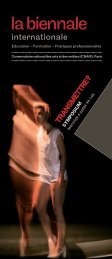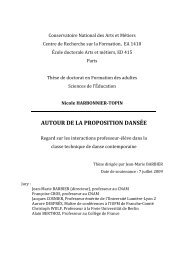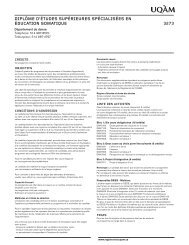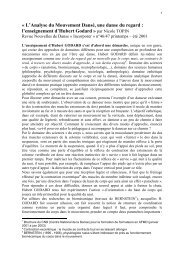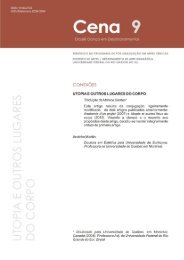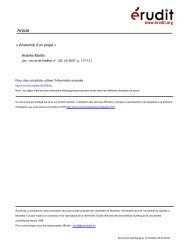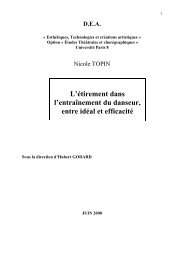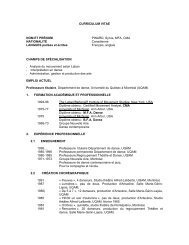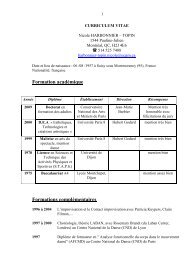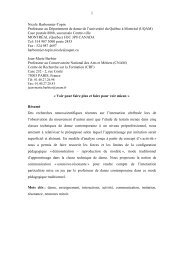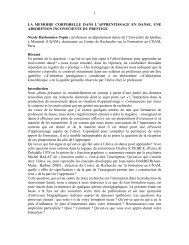Day 2 - Département de danse - UQAM
Day 2 - Département de danse - UQAM
Day 2 - Département de danse - UQAM
You also want an ePaper? Increase the reach of your titles
YUMPU automatically turns print PDFs into web optimized ePapers that Google loves.
therapeutic in different ways, they share the primary aim of giving individuals with disability an opportunity to participate in the<br />
arts outsi<strong>de</strong> of a purely therapeutic context. Through a series of interviews with artistic directors and participants of mixedability<br />
theatre companies comprised of members with/without intellectual disability, this paper will explore the challenges these<br />
companies are faced with when <strong>de</strong>fining themselves as artists.<br />
12:15-1:00pm<br />
Buffet Lunch (provi<strong>de</strong>d)<br />
Phoenix Theatre<br />
1:00-4:00pm<br />
a) Upsurges of the Real (Part 2) George<br />
Seminar Organizer: Jenn Stephenson (Queen’s University). Participants: Catherine Graham (McMaster<br />
University), Isabel Stowell-Kaplan (University of Toronto), Kimberly Richards (University of Calgary),<br />
Johanna Lawrie (University of Toronto), Donia Mounsef (University of Alberta), Matt Jones (University<br />
of Toronto), Jordana Cox (Northwestern University), Emily St-Aubin (University of Alberta), LJ Nelles<br />
(York University), Kelsey Jacobson (Queen’s University), Nicole Edge (University of Calgary), Diana<br />
Manole (Trent University).<br />
As David Shields notes in his manifesto Reality Hunger, “every artistic movement from the beginning of time is an attempt to<br />
figure out a way to smuggle more of what the artist thinks is reality into the work of art” (3). In the last <strong>de</strong>ca<strong>de</strong> or so, artists in<br />
varying disciplines have respon<strong>de</strong>d to this perennial challenge of presenting reality by including larger and larger chunks of<br />
actual “real” stuff into their works. Theatre, however, constitutes a special case, because any staging of “real” elements is<br />
complicated by the core operation of the theatrical frame, which is to take a real thing (an actor) and turn it into a fictional thing<br />
(Hamlet). This essential fictionalizing property of theatre presents significant challenges to the representation and perception<br />
of real objects as “real.”<br />
This seminar “Upsurges of the Real part 2” aims to parse out the complex and sometimes ambiguous relationships of<br />
“reality” and fiction in what we might term reality-based or “documentary” theatre. From the analysis of the ontological status of<br />
these elements, it will be possible to connect various strategies for representing the “real” to the invariably overt politically or<br />
socially-activist intentions of these documentary works. Picking up from the fruitful work done by the participants in last year’s<br />
“Upsurges of the Real” seminar, the aim of this sequel is to extend our previous work but also to refine the focus of the group<br />
specifically toward the staging of actual material in performance. This version of the seminar has two specific objectives: 1) to<br />
bring together scholarly work in a variety of reality-based performance genres (site-specific, documentary, verbatim,<br />
autobiography) so that their strategies for managing the real can be compared 2) to begin collectively to <strong>de</strong>velop a poetics of<br />
reality-based performance.<br />
b) Dancing at the Edge: Moving (in the) West McIntyre<br />
Seminar Organizers: Alana Gerecke (Simon Fraser University) and Peter Dickinson (Simon Fraser<br />
University). Participants: Sima Belmar (UC Berkeley), David Garfinkle (MacEwan University), Alana<br />
Gereke (Simon Fraser University), Jia Wu (St. Mary’s College).<br />
Part historical recovery project, and part <strong>de</strong>monstration of the liveliness of and continuities between contemporary Pacific Rim<br />
movement practices, practitioners, and festivals, the subject of this proposed seminar is dance in British Columbia, and along<br />
and beyond the west coast of North America more generally. Taking as our point of <strong>de</strong>parture both the material site of this<br />
year’s CATR Conference, and the overall Congress theme, we are seeking to initiate a dialogue on the places of dance’s<br />
performance, as well as on dance’s performances of place. In the same way that the recent Pacific Standard Time exhibitions<br />
in LA and Southern California forced a radical reconceptualization of the accepted east coast/trans-Atlantic narrative of<br />
mo<strong>de</strong>rn art (including performance art) in North America, we are suggesting that a focus on dance- making and presentation<br />
on the west coast will generate similarly fresh perspectives on the continental and oceanic “drift” of mo<strong>de</strong>rn and postmo<strong>de</strong>rn<br />
dance, whose New York and Toronto epicenters have long been taken as hemispheric givens. Additionally, in soliciting papers<br />
addressing an array of forms, styles, histories, and regions—including important Aboriginal and Asian influences—we aim to<br />
<strong>de</strong>monstrate the diversity and complexity of west coast movement practices and audiences, challenging presumptions both<br />
about their “newness” and their “isolation.” While emanating from our own individual research interests, this seminar is timely<br />
for a number of additional reasons specific to the local dance and performance scene in BC’s Lower Mainland: Vancouver’s<br />
Dancing on the Edge Festival, the ol<strong>de</strong>st such festival in Canada, will be celebrating its 25th anniversary in 2013; the<br />
Scotiabank Dance Centre, a flagship facility and resource centre for the dance profession and the public in BC, recently<br />
celebrated its own 10th anniversary; and a resurgent Ballet BC, together with other internationally recognized companies and<br />
choreographers (e.g. Crystal Pite and Kidd Pivot), and a lively traffic between dance and theatre artists compositionally and<br />
dramaturgically, suggests that creative movement of all sorts is thriving in the region, even in the face of continued funding<br />
woes and critical neglect from the rest of Canada. Finally, as scholars who work between theatre and dance, we hope to use<br />
this seminar as a way to encourage increased participation and exchange between dance scholars and practitioners in CATR.<br />
40



